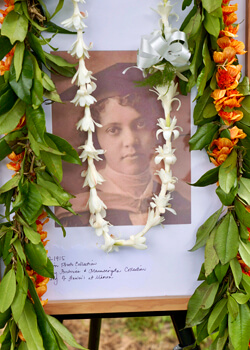
Commemorative festivities in honor of Alice Augusta Ball opened with a remembrance walk at University of Hawaiʻi at Mānoa spearheaded by the Sister Circle at Mānoa and Graduate Professional Access Program.

A special ceremony followed next to Bachman Hall near a Chaulmoogra tree planted in Ball’s honor by the king of Siam in 1935, where a dedication plaque rests in the celebrated alumna’s name. Oli (chant) formally opened a program reaffirming February 28 as “Alice Augusta Ball Day.”
Hawaiʻi Lieutenant Gov. Sylvia Luke read an official proclamation signed by Gov. Josh Green in honor of the first African-American and woman to graduate from both UH Mānoa and the United States with a master’s degree in chemistry in 1915. At the age of 23, Ball made groundbreaking contributions as a scientist by discovering an injectable form of oil from the Chaulmoogra tree, which became the most effective treatment for Hansen’s disease (leprosy) in the first half of the twentieth century.
“Can you imagine as a woman and a woman of color what kind of struggles and difficulties she had? But she was able to overcome that,” Luke said.
Recent milestones
At the ceremony, UH President David Lassner announced two major milestones honoring Ball’s enduring legacy.
- American Chemical Society (ACS) approved a nomination to award the National Historic Chemical Landmark designation to Ball for developing one of the first effective leprosy treatments in 1915. The ACS designation will be formally installed in the Alice Ball section of Hamilton Library.
- A life-sized bronze bust of Ball will be sculpted by artist Lynn Liverton and installed in late 2024 inside Hamilton Library.
As attendees soaked in the emotional ceremony on campus, members of the UH ʻohana and the community pondered Ball’s influence. Speakers included Ka ʻOhana O Kalaupapa and retired professor Kathryn Waddell Takara, who delivered a stirring poem about prevailing in the face of adversity.
“Many of those barriers are still there for all kinds of people, and I think the lesson of overcoming barriers to achieve excellence, you know that’s what the story is about, to me,” said Lassner.

LaJoya Shelly, an educational administration PhD candidate and member of UH Mānoa’s Black Student Association emphasized Ball’s inspiration.
“For me, Alice represents what’s possible. She represents not just what’s possible for my career but really what’s possible with our education that we are to be of service not just to ourselves but to our community,” Shelly said.
An accomplished scientist, academic

Much of what is known about Ball is the result of extensive research by Paul Wermager, a retired science librarian and former head of Hamilton Library’s science and technology department. Wermager has written a book on Ball and established the Alice Augusta Ball Endowed Scholarship for underrepresented minority students at UH Mānoa who, like Ball, hope to enter the science field.
“She gave actually hope to millions. Not only to patients but also to physicians when they could see their patients improving after the injections it showed that maybe leprosy was not incurable,” said Wermager.

Ball graduated from UH Mānoa (then the College of Hawaiʻi) in 1915, and her impressive list of firsts grew. She went on to become the school’s first African American female chemistry instructor and department head. Due to her research with kava for her master’s thesis, Ball was recruited by the U.S. Public Health Service (Kalihi Hospital) to use the same technique to find a treatment for Hansen’s disease.
She made the fundamental scientific contribution by applying a new method of isolating ethyl esterification from fatty acids of the chaulmoogra oil so it could be effectively administered to patients by injection.
This isolation technique, later called the “Ball Method,” was the first successful treatment for Hansen’s disease that was used on thousands of patients around the world until the introduction of sulfone drugs in the mid-1940s. The Ball method was used to treat patients in Kalaupapa, permitting them to return to their families after being banished to isolation facilities on the remote Molokaʻi peninsula.
Early death

Sadly, Ball died on December 31, 1916, at the age of 24, before publishing her groundbreaking work. The president of the College of Hawaiʻi, Arthur Dean, continued her work and published her findings, but failed to mention key research she conducted. He mass produced the injectable treatment and was praised for the discovery, calling it the “The Dean Method.” In 1922, Harry T. Hollmann, the doctor at Kalihi Hospital who encouraged Ball to explore chaulmoogra oil, published a paper and attributed her process as the “Ball Method,” giving her the proper credit she deserved.
In 2007, the UH Board of Regents posthumously awarded Alice Ball their Medal of Distinction, for her exceptional accomplishments and significant contributions to the university, state and the world. The medal is on display at UH Mānoa’s Hamilton Library alongside her portrait.
Alice Ball Day in Hawaiʻi had previously been proclaimed in 2000 to be February 29, which falls on Black History Month, after what is now Kalaupapa Month in Hawaiʻi (January) and before Women’s History Month (March). In 2022, Gov. David Ige’s proclamation declared February 28 as “Alice Augusta Ball Day.” It was reaffirmed by Gov. Josh Green in 2023.
Read more about the Alice Augusta Ball Endowed Scholarship on UH News.


